|
|
HOW
MY INTEREST IN IRISH SWEATHOUSES STARTED.
My discovery of the existence of sweathouses was entirely due to
Estyn Evans' Field Guide to Prehistoric and Early Christian Ireland,
published in the mid-sixties. He mentioned the Rathlin one (which
I never found) and the Tirkane sweathouse near Maghera, co. Derry,
which I decided to visit along with the fine portal-tomb at nearby
Tirnony.
It was in a glen owned by a Miss Dogherty who had serious arthritis
and was getting on in years. She was thrilled that I wanted to see
her sweathouse, and she took me down the slippery slope to show
me it. After that, anytime I was in the area I called in with her.
I brought her the first peach she had ever seen, and she told me
that she had only once seen the sea (at Larne) and was still amazed
by the waves. She was a splendid woman. Later I went to see her
in hospital after a cataract operation (not the outpatient event
it is today), and later again I went to see her after a nephew (I
think) had had her house 'done up' with a grant. Gone was the turf
fire and the cosiness, replaced by a lot of formica. She didn't
like it at all.
|
For information on
Meso-American
stone-built
sweathouses
click
here >
and
here
>
|

slide-show
IRISH
SWEATHOUSES
AND THE GREAT FORGETTING
Anthony Weir
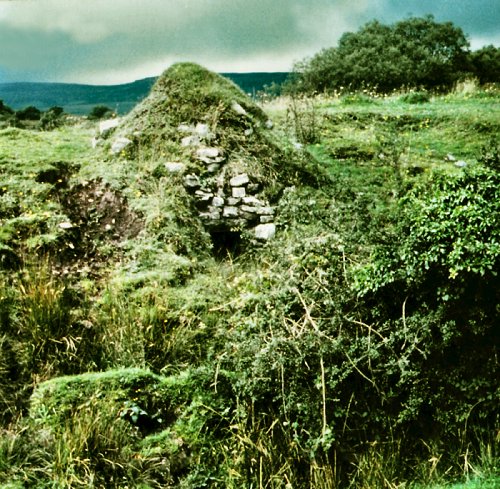
click
for a longer view
Are
Irish sweathouses a continuation of a prehistoric tradition of
inhaling consciousness-altering smoke, recently overlaid or amalgamated
with the prophylactic function of saunas ?
Cannabis is not likely
to have been used in Ireland for a millennium at least, but a
much more seriously-numinous means of widening the awareness is
still to be found all over the island: Psilocybe semilanceata,
or "magic mushrooms"
Could
the sweating cure possibly be a purifying ritual preceding
psychedelic experience ?
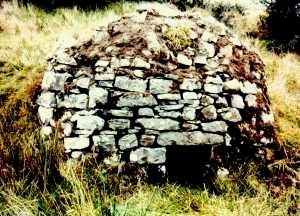
Killadiskert,
county Leitrim
Irish Sweathouses are small, rare, beehive-shaped, corbelled structures
of field-stones, rarely more than 2 metres in external height
and diameter, with very small "creep" entrances which
may have been blocked by clothing, or by temporary doors of peat-turves,
or whatever came to hand. Most of those which survive could not
have accommodated more than three or four sweaters. They resemble
the small 'caves', built into banks, in which many Irish natives
were reported to live in the seventeenth century.
Some have chinks
to let out the smoke, but they were necessarily cleared of fire
and ash before use - so any chinks (deliberate or otherwise) in
the rough construction would have served as ventilation ducts
in a cramped space. Where these were too big, they were stopped
with sods or with mortar.
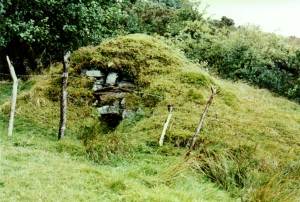
Cornamore, county Leitrim
They were often covered with sods of earth to counterweight and
stabilise the corbelling, and these would also have acted as insulation
after firing. That they were fired is certain, for soot remains
on the ceilings of some.
Thus they are different
from North American sweat-lodges or inipis, which were
rarely if ever stone-built, and were heated by carrying hot stones
from a nearby fire. Northern European saunas and bath-houses are
a modern variant, with an enclosed stove upon or around which
stones were placed. Stone retains heat very well.
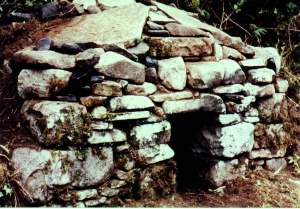 click
for high-resolution photos
click
for high-resolution photos
Cleighran More, county Leitrim: beside a
stream

Dowra, county Leitrim.
The first - and only detailed - account of Irish sweathouses came
from Latocnaye in the late eighteenth century: a man who spoke
no Irish. [A Frenchman's Walk Through Ireland, translation
reprinted by Blackstaff Press, Belfast 1984].
The rural Irishry who used them would not necessarily have told
such a man - or any Dubliner, Anglo-Irishman or Englishman in
a carriage - what functions the sweathouses served. To this day,
the rural Irish of the west (like peasants everywhere) will tell
tourists what they think they want to hear, halving distances
so as not to discourage the traveller, and enthusiastically recommending
the nearest café. Nevertheless, reports of the Sweating
Cure have been given in recent times to Brian Williams of
the Archæological Survey of Northern Ireland, by people
who are unlikely to have heard of it from the archæological
literature, or from outside their immediate area.
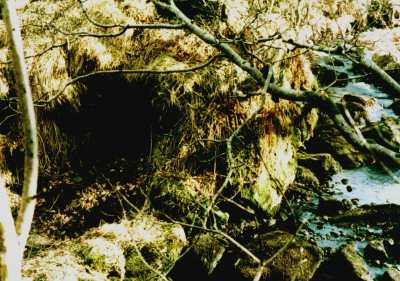
Ballydonegan, county Derry: also beside
a stream
A number of early writers on the Turkish bath quote the following
from Catharine Gage, wife of the Reverend Robert Gage of Rathlin
Island (between county Antrim and the Mull of Kintyre in Scotland),
who wrote:-
'Small buildings
called sweat-houses are erected, somewhat in the shape of a beehive,
constructed with stones and turf, neatly put together; the roof
being formed of the same material, with a small hole in the centre.
There is also an aperture below, just large enough to admit one
person, on hands and knees. When required for use, a large fire
is lighted in the middle of the floor, and allowed to burn out,
by which time the house has become thoroughly heated; the ashes
are then swept away, and the patient goes in, having first taken
off his clothes, with the exception of his undergarment, which
he hands to a friend outside. The hole in the roof is then covered
with a flat stone and the entrance is also closed up with sods,
to prevent the admission of air. The patient remains within until
he begins to perspire copiously, when (if young and strong) he
plunges into the sea, but the aged or weak retire to bed for a
few hours.'
[Gage: A History of the Island of Rathlin, 1851]
He also mentions
that young women use it for their complexion after burning kelp,
and that after about 30 minutes use, their skin is much improved.
There
is very little mention of sweathouses on the Web, apart from a
summary of conclusions from a rescue-dig at Rathpatrick,
county Kilkenny - whose author, knowing little about steam baths,
saunas, or simple physics (or indeed about the sparse literature
on the subject of Irish sweathouses), actually thinks that pouring
water on hot stones increases the temperature! This summary suggests
that temporary sweathouses of the North American type (made of
bent wands and skins or fabric), with a pool, might well have
existed in Ireland during the Bronze Age - around 2,500 BCE. The
only problem is that the report suggests that stones were heated
in a hearth a couple of metres outside the temporary sweathouse,
a labour-intensive operation, since it would be easier and safer
to erect the structure over the hot stones in a hearth than to
roll very hot (presumably rounded) stones down into what amounts
to a tent. The author of the summary suggests, however, that they
might have been carried on forked sticks. A correspondent from
Rhode Island tells me that he and his friends use a shovel - or
preferably a pitchfork - to transport glowing stones into the
inipi. and that there are reports of deer-antlers also
being used. "The stones are commonly the size of a man's
head and never gathered from or near a river - because they explode."
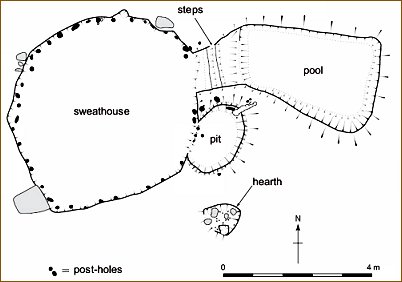
Presumed
sweathouse, Rathpatrick - Headland Archaeology Ltd.
Whether or not the temporary Rathpatrick structure was a place
to sweat in, no stone-built sweathouse standing today is likely
to be earlier than the second part of the 19th century, because
of the fragility of the structures. If indeed they were built
at that time for prophylactic use or to ease rheumatic pain, then
(unless they were a curious 19th-century fad introduced by an
eccentric) they very likely had an earlier - and more effective
- function.
The first thing
to note is that the present distribution is in the poorest parts
of the ignored counties of Ireland: Fermanagh, Leitrim and Cavan,
as well as northern Sligo - though 'outliers' have been identified
in Wicklow, Cork and Kerry.
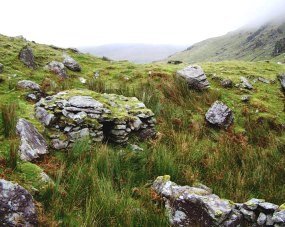
Coomura, county Kerry (photo by Aidan Harte)
They are often tucked away in rather magical, liminal places,
near little streams and/or in little brakes or copses. This differentiates
them from lime-kilns (also common in central Leitrim and NW Cavan)
which have a similar construction but are much taller, more easily
accessible - and have even-smaller "entrances" which
only a stoat or a small dog could get through.
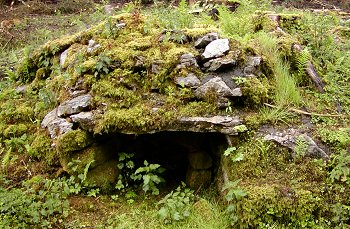
A typical lime-kiln of NW Cavan - with missing
chimney.
The inhabitants of this area were until very recently amongst
the poorest and most undernourished in Europe. They lived on potatoes
and whey, never saw fruit, and after the Famine of the 1840s brought
a continuing revulsion against the eating of anything wild and
natural (e.g. blackberries and elderberries, let alone sloes,
wild damsons, rose-hips, chickweed, nettles, sea scurvy grass,
mushrooms etc.) had almost no variety of diet. Healthy pre-Famine
infusions gave way to a dependence upon strong imported tea laced
with imported, addictive and teeth-rotting sugar: expensive items
which allowed little cash for real nourishment in a largely-subsistence
society where great labour was required simply to provide fuel
for winter.
click
for a closer view
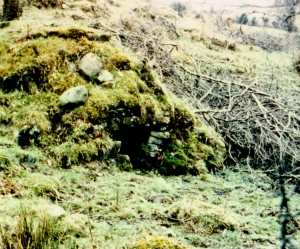
Mullan, county Fermanagh
Sweathouses were carefully built, often corbelled, but sometimes
slab-roofed, well away from permanent dwelling-houses and often
from tracks. They would have had to be tucked away from the eyes
of land-agents who might have charged rent on them. But they could
have been close to impermanent dwellings, such as bivouacs of
tarpaulin or rags and sticks, or the "cabins" of wattle
and daub which give their name to county Cavan. It would have
taken two or three skilled wall-builders two days to find and
select the stones and build one. Some townlands (named
units of land of very variable size usually smaller than anEnglish
parish) had several sweathouses, and even now three of four townlands
have more than one sweathouse, intact or ruined.
The corbel-roofing
goes back, of course, to prehistoric times, and is found in Neolithic
tombs all over Europe. It involves the laying of stones in an
ever-diminishing coil or spiral until it can be finished with
a single stone.
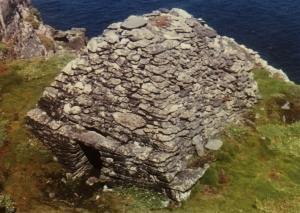
 Corbel-roofed 'oratory'
Corbel-roofed 'oratory'
on Skellig Michael, county Kerry
[click
on the picture to see clocháns on the rock]
Corbel-roof of prehistoric tomb,
Knowth, county Meath 
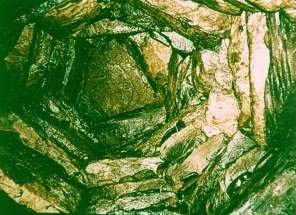
All sorts of corbelled rustic
structures (mostly dating from the 19th century) can still be
seen across Europe, with functions as various as hen-houses, dog-kennels,
look-outs, shepherds' huts and stores. There
are hundreds in the French département of the Lot
and adjacent départements of Quercy-Rouergue, where
they are known as gariotas
when small, and caselas or cabanas when larger.
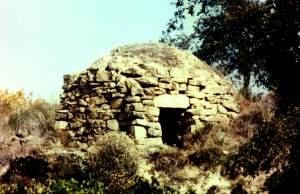
Corbelled shepherd-hut, Artajona (Navarra),
Spain
and a gariota or casela in Quercy, France.

They all, however, have proper doorways, unlike the diminutive
entrances of Irish sweathouses. These required considerable labour
to heat. One report says that two donkey-cartsful of turf
(which is what peat is called in Ireland) was required to get
the stones to a high enough temperature for the sweating - and
this is probably correct. In a society where not everyone had
rights of turbary (the cutting of peat), and turf was burned in
an open hearth, piece by frugal piece, this was quite an extravagance.
Turf-digging is labour enough, but the throwing of it up the turf-bank,
the stacking in small piles to dry in a wet climate, and its transportation
to the dwelling-house still takes a several weeks of the summer,
and still many Irish men working in Britain will come home in
the summer to help with the turf. The prodigal use of it to heat
up a sweathouse, presumably well away from the dwelling, suggests
that sweathouses were in some way very important.
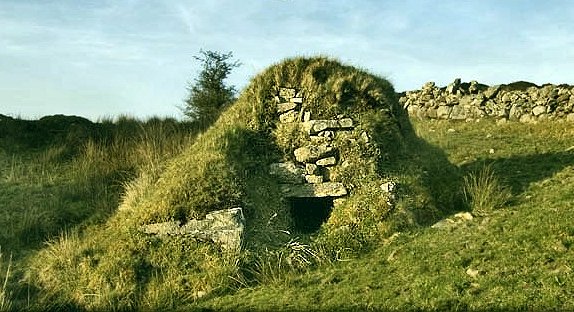
Legeelan, county Cavan
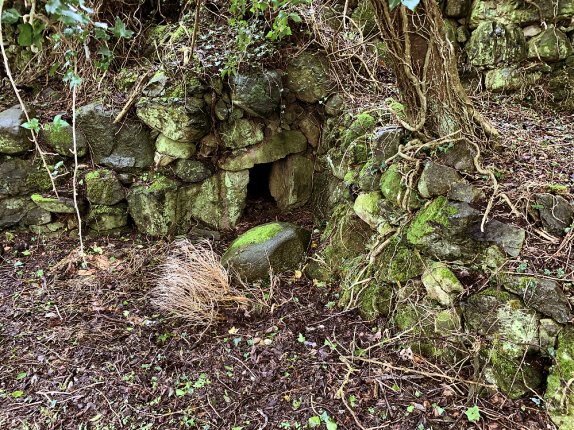
photo by Padraig Cumiskey -
click to enlarge
Doolargy, county Louth (one of several)
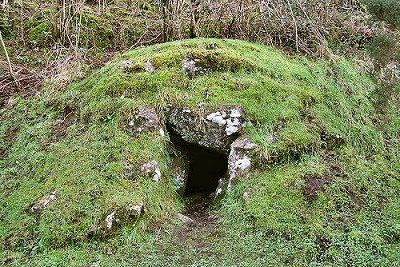
Parsons Green, South Tipperary
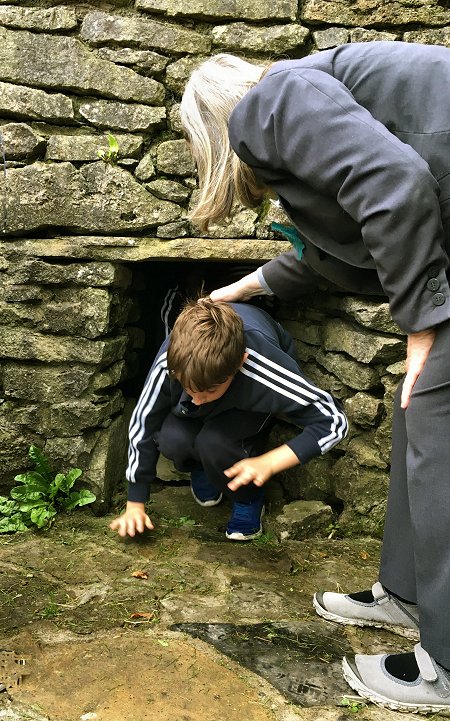
Parke's Castle, county Sligo
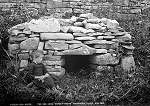
In
line with the Victorian insistence that explanations should
be as free as possible from excitement or sin, it has
generally been accepted that sweathouses were resorted
to as a prophylactic sauna-treatment for aches and pains.
But
far more aches and pains could have been incurred in heating
a sweathouse than would ever have been alleviated. For
a start, the entrance is as little as 75 cms high. To
light a turf fire, maintain it and sweep out the ashes,
ans strew the floor with bracken or rushes was no easy
task. Even if the roof were partly dismantled to put the
turf in, this would have been almost as awkward as bringing
or throwing it in through the entrance - and the hot ashes
would still have had to be swept out.
Myles
McMorrow recounted that : Each
person brought a leaf of cabbage and put it on his head
to keep the head cool and avoid headaches. An hour or
so being spent in continuous perspiration the patient
clothed himself and hastily hurried home. He then betook
himself to bed having had a hot drink of whey prior to
retiring.
Those old people found continuous relief from pain from
the fore-mentioned process.
In
a society where everyone had rheumatic pains and arthritis
at the very least, and where it was regarded as the normal
human condition, it is it really likely that sweathouses
several hundred metres from the nearest (stone) house,
holding a maximum of 5 people in considerable discomfort
and some risk of fainting or even burning, would have
been used for the uncertain alleviation of aches and pains
?
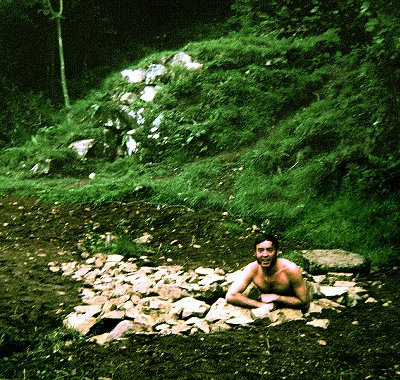

click
on the picture for a better photo
Tirkane, county Derry, with shallow well in foreground.
Photo taken in 1974.
The
better-off rubbed themselves with poitín and
patent rubs on sale at markets and fairs; the poorer drank
what they could get - poitín, or, in mid-Ulster,
ether - to ameliorate bodily discomfort. In any case,
sauna treatment is of no avail to such complaints as sciatica,
arthritis, and the aching backs still suffered by a high
proportion of the more mature population. Arthritic hands
and feet would be relieved more easily and effectively
by immersion in warm peat-ash from an overnight fire than
by squatting uncomfortably in a tiny, dark place.
Nevertheless,
there is this account on the Duchas
site:
There
was one on Phil Ward's land in Deffier [county Leitrim]
and the walls were there up to ten or twelve years ago.
Joseph & Thomas Mahon saw it being used.
The people suffering were also bled at the sweat house
if sweating was not able to bring relief.
The sweat house was beside the old house Terry (Turlough)
Lynch was born in. He could bleed and sweat but not as
good as the Lynches before him. The Lynches for generations
bled people.
If fever was supposed the sufferer was brought to the
sweat house and if not relieved by sweating was bled.
Also
this:
In
a place locally known as Claghan in the townland of Carrickhue
[county Derry] there lived an old woman in the
middle of the last century who was well known all over
the parish for being able to cure many ills which existed
at that time. There was no surgical operations for internal
diseases such as appendicitis so all such cases were taken
to old Martha Douglas as she was called for treatment.
In the garden she had what was known as the "Sweat
House" constructed much to the design of a lime kiln.
Here the patient was placed rolled up in blankets on a
large flat stone with a fire underneath. This operation
continued from twelve to twenty four hours. Then the patient
was removed and placed in a bed where she administered
medicine made from herbs. After three or four days' treatment
the patient was completely cured.
Old Martha never told the secret of her cures which died
with her. But for many years the "Sweat House"
stood until at last it was removed to make way for the
plough.
click
to enlarge
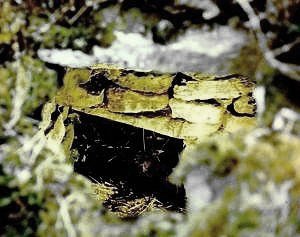
Sweathouse doorway seen through
a hole in the corbelled roof,
Cuiltia, county Leitrim
If
they were not used for prophylactic purposes, why would
sweathouses (never more than 1.75 metres high internally
and two metres in internal diameter) be built in such
numbers ? (It is safe to assume that those which survive
represent a tenth or less of the total built just in the
county Leitrim.) What else could they have been used for
? And when were they introduced ?
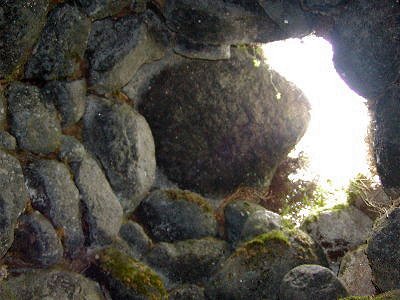
A hole in the corbelled roof photographed
from inside the sweathouse at Annacarney in county Wicklow,
far from the current (surviving) main distribution, but
in a remote location. (Click the picture for more.)
Mrs
McLoughlin of Tullynafreave (Leitrrim) claimed in 1992
that her maternal great-grandfather built the sweathouse
standing some 50 metres from her modern dwelling to save
his wife the trouble of travelling to the sweathouse in
neighbouring Meenaslieve. She said that her grandmother
and perhaps her mother also had used it, and did not think
that their spouses had done so. But whether this is an
isolated example of late construction (say around 1885)
is impossible to determine. Similarly, it is impossible
to establish a connection with the coal-mines (in use
from the late eighteenth to the late twentieth centuries)
that are at the heart of the present distribution of sweathouses
- now reported also from south-west Scotland.
Sweathouses
are, of course, part of a circumpolar phenomenon which
produced the now well-known Finnish sauna.
The Turkic tribes who moved from central Siberia and eventually
overthrew the Byzantine Empire, seem to have easily adapted
to the Byzantine and Roman steam-bath, producing the hammam
or Turkish Bath. The North American form was the sweat
lodge, used not for mere hygienic reasons, but for
spiritual and physical purification, and sometimes as
part of the initiation procedures for boys' passage
into manhood. We can be sure that the Finnish sauna was
not used for merely hygienic reasons before the 19th century
obsession with cleanliness as the prime virtue took hold
in the Protestant countries of the North.
click
for a 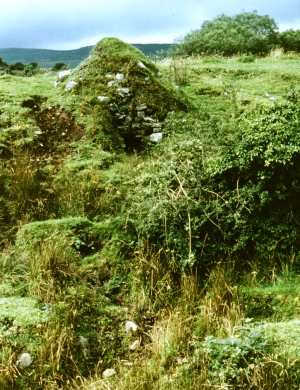 larger
photo
larger
photo
Gubnaveagh, county Leitrim
The
first Turkish Bath to be established in the British Isles
was in county Cork in the 1860s - so there is no likelihood
that it inspired simple Irish sweathouses, concentrated
much farther north.
The
Finnish sauna was an offshoot from a Siberian-Mongolian
practice, so it is reasonable to suppose that the Irish
sweathouse came from Scandinavia via the Vikings or their
Gallowglass
successors in the Northern Isles at some time between
the 10th and the 15th centuries. That they are not found
near the Viking settlements can be explained by the subsequent
Norman and English occupation and expansion of those areas.
Before
their secularisation, saunas were part of the universal
combination of religious, medicinal and psycho-therapeutic
modes which have only recently, like much else, been split
off and compartmentalised by Western science and pseudo-science.
Our culture has, as a consequence, taken 'exotic'
and exciting elements of other cultures' psycho-social
therapies (coffee, cocoa, tobacco, cocaine, cannabis and
so on) as mere stimulants and 'highs'. The Turks
made the public hammam a part of quasi-religious
male confraternity. The Finns have likewise made the communal
sauna a kind of men's club. Sweating is one of the
many ways of altering consciousness, particularly when
it is part (as sometimes in North America) of a series
of tests and ordeals - and especially when it is done
in the dark. But there is no evidence that the small
Irish sweathouses were used in the distinctly religious
and reverential way that the large North American sweat-lodges
were used - and such a highly-evolved function is most
unlikely. Something that few people allow themselves
to realise is that many Native Americans were much more
emotionally mature than the European invaders, who had
(and have) destructive technologies way beyond their wisdom
or insight or sensibility.
The
medicinal psycho-therapy of Siberia and Mongolia, which
is still practised by shamans both male and female, involves
mushrooms (Fly Agaric), alcohol, sweating and rapid cooling,
fasting, whirling, sleep-deprivation and so on. These
produce visions and out-of-body experiences, and are aids
to achieving more aware states of consciousness than 'Western
values' approve of, whereby the shaman-practitioner
can see causes of illness or malaise, and the non-shaman
can be suitably awed by the psychic forces released by
the unblocking effects of physical ordeal and psychoactive
drugs.
Herodotus
describes the Scythian practice of altering consciousness
through cannabis by throwing the seeds on hot stones inside
a tent and inhaling the vapour - the smoking of cannabis
and opium is a rather late development. Long before the
Scythian incursions, however, cannabis seems to have been
inhaled at La Hougue-Bie on the island of Jersey, where
21 pottery vessels marked with burnt resin were found
in the untouched chamber recently discovered. Consciousness-improving
substances have, of course, been found also in other European
sites: the Iron Age site of Wilmersdorf, for example,
where remains of cannabis were found in an urn.
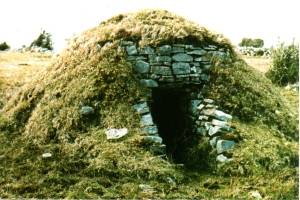
Sweathouse with unusually large
and grand entrance
recalling a passage-tomb, Annagh Upper, county Leitrim
Closer
to Ireland there have been serious suggestions that the
"burnt mounds" also known as "ancient cooking-places"
or fulachta fíadh, found in huge numbers
in Ireland - and also in Britain - might have been used
as sweat-lodges in the North American style, or as places
for warm-water bathing. These shallow ponds, heated by
rolling hot stones into them, could have had many purposes,
of course - and warm baths would have been an obvious
secondary function.
Could
Irish sweathouses be a continuation of a tradition as
old as the fulachta fíadh ? They are very
flimsy structures, easily subject to total demolition
by livestock, and would survive from prehistoric times
only through the most extraordinary circumstances - so
no evidence is likely to emerge. None has ever been excavated.
Their
general disuse seems to have started after Catholic Emancipation
in 1829. After the horror of the Famine, the Catholic
church set about removing all 'pagan' and 'immoral' practices
on the island, and instituted a very unpleasant kind of
Catholic Calvinism (reinforced by the reactionary pietist
policies of Pius IX) of which everyone is now aware, and
which is described in several Irish novels, notably Old
God's Time by Sebastian Barry.
Patrick
Shields wrote to historian Seaton F. Milligan in 1890
that as many as six or eight men stripped off and went
in, then all openings were closed except what afforded
a little ventilation. When they could suffer the heat
no longer they came out and plunged into a pool of water
within a yard or two of the sweat house. Naked, illiterate
labouring men packed close together in a primitive, sensual
practice would certainly not have been approved of by
Ireland's new bourgeoisie of interfering and sexually-repressed
clergy.
On
the other hand, Seán Ó Céilleachair,
a teacher in a Co. Leitrim National School some decades
later asked his pupils to ask their parents about sweathouses.
Here is part of one hearsay account, from the duchas
website, where many such reports have been
scanned and posted.
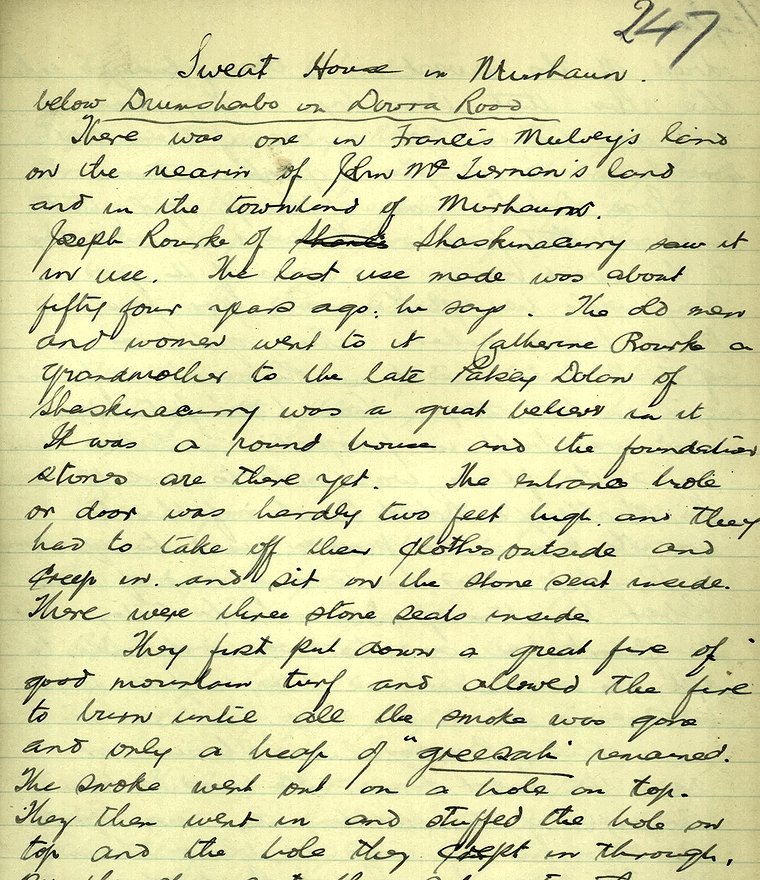
I
have never seen a stone seat built into a sweathouse,
though I have seen candle-niches.
If the Church was appalled by a group of naked men packed
into a sweathouse, this account of both men and women
'taking the cure' would have caused priestly heart-attacks,
and possibly retribution.
The remoteness of the ones now found
may reflect a purge of them by clerics and 'pious' types,
and a desire to keep them out of sight of the new oppressors..
Greesah
is, interestingly, Scots-Irish
for embers.
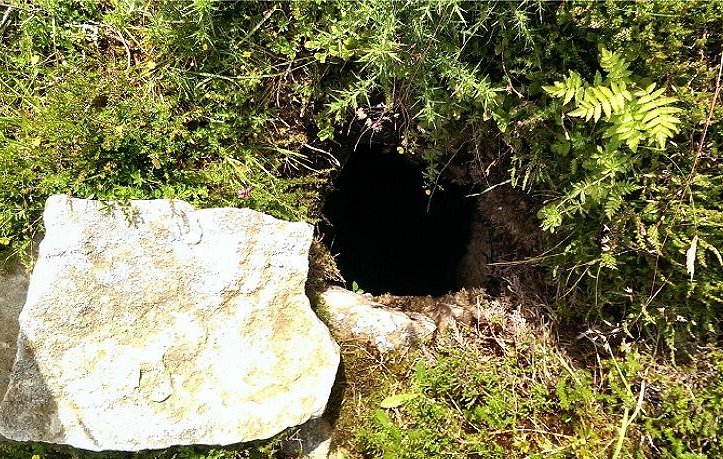
Smoke-hole eand closing-stone on top
of the sweathouse at Lurgaboy, co. Roscommon.
Photo by Katie Kearns, 3016.
Could sweathouses be survivals of consciousness-improving
chambers as at La Hougue-Bie and Wilmersdorf, latterly
overlaid with the prophylactic function of saunas ?
Cannabis
is not likely to have been used in Ireland for a millennium
at least, but a much more seriously-numinous means of
widening the awareness is still to be found all over the
island.
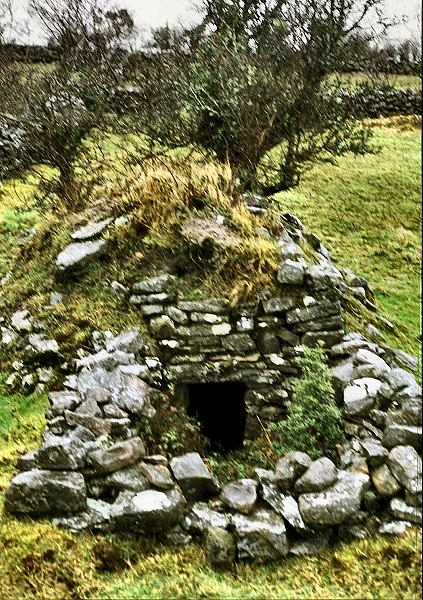
Cornaguilla, county Leitrim.
There is
a great deal of literature on the effect and use of various
kinds of mushroom (Psilocybe spp. and Fly Agaric).
The appearance of the formerly ubiquitous "magic
mushroom", Psilocybe semilanceata, fits rather
well with descriptions of pixies, leprechauns and other
'little green men'. A more gross mushroom-spirit
is the modern Santa Claus, dressed in the colours of Fly
Agaric, associated with reindeer (from whose urine the
unmetabolised but detoxified active constituent was (reportedly))
drunk bv the shamans of sub-arctic reindeer-herdsmen,
who enters down a chimney and brings gifts. The entrance
to many circumpolar dwellings is also the smoke-hole,
as in Irish sweathouses. In our culture of acquisition
the gifts are meaningless objects of desire rather than
real numinous Gifts, and the shaman figure (who degenerated
to Father Frost in Westernised Russia and Scandinavia)
coalesced with St Nicholas, the Three Magi and the ancient
gift-tradition within the Saturnalia.
However,
there is absolutely no evidence of the ingestion of Psilocybe
in Ireland.
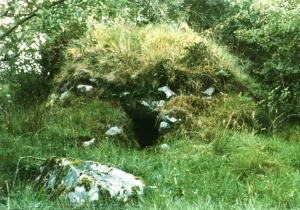
Corradeverrid,
county Cavan, reportedly built by a Dr Greden
If
Irish sweathouses were used like the secularised hammam
and sauna, why were they not built close to stone-built
dwellings and their turf-stacks ? Why were they, as reported,
used infrequently - mostly in the Autumn ? Were they used
exclusively by one sex ? Does one report of an "itinerant
bath-master" indicate a psycho-therapeutic use supervised
by a travelling doctor-shaman or Wise Man ? And why, in
a country which, until the use of chemical fertlisers,
was in October and November (the time of The Gap of
the Year, Samhain, Hallowe'en) carpeted with Psilocybe
semilanceata, also known as Liberty Caps, is there
no record of their use ? These mushrooms are still plentiful
on marginal land and on the edges of chemically 'fertilised'
agricultural land. But there is a pattern of "collective
forgetting" of mind-expanding plants and their
extracts by cultures which inevitably adopt manufactured
mind-numbing drugs such as alcohol. Thus the identity
of Soma was lost, and only inactive "substitutes"
were identified.
It
is possible) that Psilocybe mushrooms - probably
as an infusion, maybe with other herbs - were consumed
up to the time of the Famine - but of course the agonising
and protracted trauma of the hungry years and the halving
of the population by death and emigration affected Irish
behaviour and negative or hostile attitudes to Wild Food
or "famine food" - such as nutritious nettles,
rose-hips, elderberries, weall-pennywort, and so on. After
the Famine, only grocery-store victuals were eaten. Even
now, eating blackberries is far from universal in Ireland:
those who pick them tend to be English, other foreigners,
or local children paid (a penny a pound, as I remember
in the 1960s) to gather them.
click
to enlarge 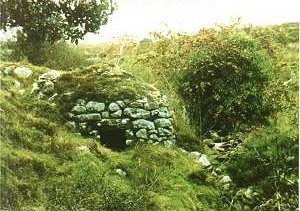
Tullynahaia, county Leitrim
For
the decline of Irish traditions right across the spectrum,
the Famine was Pelion piled upon the Ossa of Catholic
Emancipation of 1829. This resulted in the rapid application
to Ireland of a very urban-English Victorian-puritan 'respectability'
that ran counter to many of the old ways and practices
which had survived until the Penal days - practices which
were bowdlerised and Christianised when they could not
be suppressed. Ireland became for the first time - and
remained until the end of the 20th century - a highly-conservative
society which had also lost its traditions, and whose
mores came from the right wing of the Catholic church.
This is in contrast to Italy, for example, where all sorts
of "pagan" survivals (from frog-cults and wolf-veneration
to bleeding statues) can still be found in the centre
and south, while sceptical atheism is almost the norm
in Tuscany and the north.
click
for a 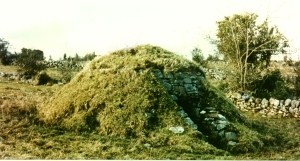 larger photo
larger photo
Annagh Upper (side view), county
Leitrim.
So,
after the Famine, few would have claimed or admitted to
remember the eating of Psilocybe, which, it should
be noted, were free, abundant and (through drying) available
all year, and produce a state of consciousness far above
that induced by alcohol – which requires a compicated
process to produce, and money to otherwise obtain. The
world-wide phenomenon of the replacement of natural, easily-ingested
and fairly benign plants by manufactured, expensive and
toxic alcohol is a sad paradigm for the take-over of the
world by toxic "turbo-capitalism".
In
the same way, 'pagan' practices such as painting
or capping phallic stones, using cure-stones (which were
promptly and cleverly dubbed curse-stones) some
of which still survive, wild dancing (for which the Irish
were famous) and the veneration of Fairy Thorns were discouraged.
click
the picture for more 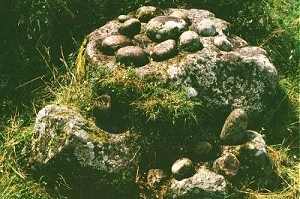
Cure-stones, Killinagh, county Cavan
But
Psilocybe mushrooms would surely have been
recognised and taken (probably as a tea, or even as they
were collected) in Ireland (and elsewhere), since they
were so plentiful (right up until recent poisoning of
so much agricultural land) - yet we have (so far as I
know) no record, no evidence. Humans never miss out on
a source of intoxication or hallucination (from ayahuasca
to glue), no matter how complicated the process of extracting
it. Moreover, traditional societies 'knew their mushrooms'
even better than they do today (everywhere except the
British Isles). Did whiskey (first recorded in the 12th
century) gradually supplant mushrooms ? I
If
dark, chthonic sweathouses had a psycho-therapeutic function
stretching back at least to Bronze Age times, we can be
sure that they too would have been discouraged by the
twin powers of Church and State. By the time that uncasual
enquiries started (after the First World War) they had
fallen into desuetude, and their use had been erased (like
much else) from the collective memory. If they had been
widespread across the island, they were destroyed by agricultural
encroachment in the fertile lowlands, surviving
only in the remotest districts or by sheer accident.
The Church abhorred mystical or psychedelic experiences
that it saw as demonic and could not control. It was much
happier with alcohol, the consumption of which was regulated
in the first instance by Her Majesty's Customs and Revenue
men, except in remote and 'backward' parts.
Small
wonder that enquirers were fobbed off with glib explanations
of autumnal prophylaxy and 'sweating out the bad'
as Mrs McLoughlin of Tullynafreave expressed it. But sweating
out the bad might very well have been more than a
figure of speech in a desperately poor region in a poor
country where every new mouth to fill was a curse, and
one too many could reduce a family to destitution and
starvation. Mrs McLoughlin stated that only the women
in her family had used the sweathouse. If only women used
them, it is very possible that they were part of a procedure
to induce miscarriage in unwanted pregnancies. Hot baths
are a classic part of this procedure, and more effective
if followed by cold ones. Ingestion of a large dose of
Psilocybe mushrooms is also abortifacient. The water which
is near so many sweathouses could also have been most
useful for cleansing after a successful miscarriage. And
finally, the distance and in some cases difficulty of
access would ensure privacy and itself aid the process.
The 'Itinerant Bathmaster' could well have
been a Wise Man practised in the art of inducing miscarriages.
Perhaps he was also a sweathouse-builder
– for it would take some skill in building dry-stone
walls to construct a sweathouse.
Sweating
and dunking in cold water could have been a purifying
prelude to the consumption of mushrooms, perhaps at home.
I have gone through the reverse procedure (in the 1980s)
during which I felt physically intimate with 'Nature',
sitting on the ground and feeling roots growing out from
my anus.
They could not have been social like Finnish saunas or
Struell
Wells in county Down. Nor were they 'sacred
spaces'. As to their origin, a distant Viking connection
is quite possible, because artefacts and traditions can
hang on for hundreds of years in remote areas. Maybe Sligo
in the NW, close to county Leitrim, was the chief point
of entry. Saunas are and presumably always were made of
wood, hence quickly rotted and forgotten, but in stony
and boggy areas an adaptation could well have occurred
and survived. There are descriptions in the National Folklore
Collection about sweathouses with clay walls and thatch
rooves. It is worth noting that the isolated group in
county Louth is not far from Carlingford, a Norse settlement
with a Norse name.
By
the dawn of the 20th century very few - if any - people
knew how sweathouses had been used, for in Ireland the
rupture of handed-down knowledge, especially from mothers
to daughters, occurred earlier than almost anywhere else
in rural Europe. The Great Famine resulted, as I have
said, in a collective Irish shame associated with traditional
practices, the native language, and "wild food".
It is curious that no accounts of them suggest an 'otherworldly'
connection; no mention of the sídhe or 'good
folk' as there has been been with reference to mounds
or cairns and other ancient structures. This would tend
to contradict the mushroom-imbibing theory.
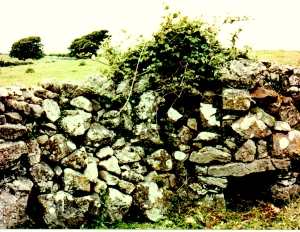
Assaroe,
county Donegal
How
much arcane knowledge died in the hedges with Famine victims,
or was carried across the ocean to America and deliberately
forgotten there, we will never know. What we can be sure
of is that there has been in Ireland a Great Disremembering
(encouraged by the Church) which acted as undertaker to
the Great Hunger, and may still not have run its course.
And although sweathouses still lurk in secret places and
leprechaun-hatted Psilocybes still grow, their
use and possible connection remain as obscure to us as
the mind-set of Mesolithic hunter-gathers, the cosmology
of Celtic kinglets, or the ecstasy of Atlantic anchorites.
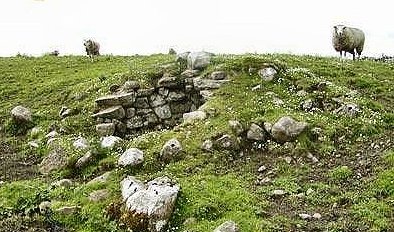
Damaged sweathouse, Eskerbawn, county Roscommon.
_________________________________________________________
[This text has been expanded from articles
which previously appeared in
Archæology Ireland (volume 3 number 1, 1989)
and The Ley Hunter (number 119, September 1993).]
Most of the photos in these pages are from slides taken
in the 1970s.
An
article on Navajo sweating-structures, with some text
taken verbatim from these pages.
For
valuable accounts of sweathouses and people who used them,
click
here

View
slide-show
>
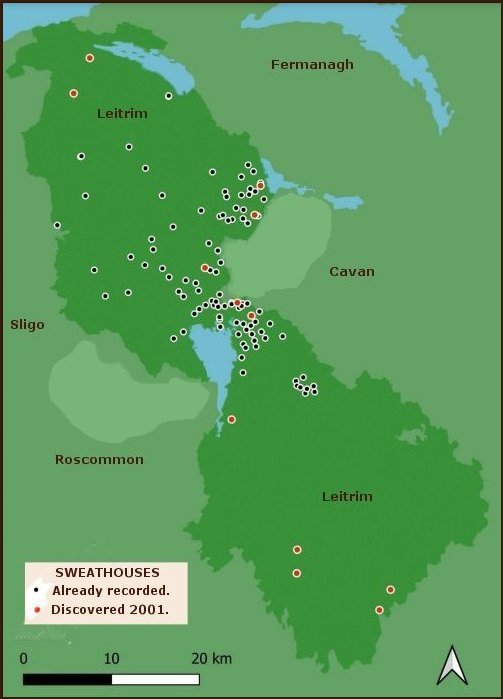
Sweathouses in county Leitrim (after
Leitrim
Sweathouse Project Report, 2001).
The pale green areas indicate concentrations in adjoining
counties.
On the map below, the arrow points to county Leitrim.
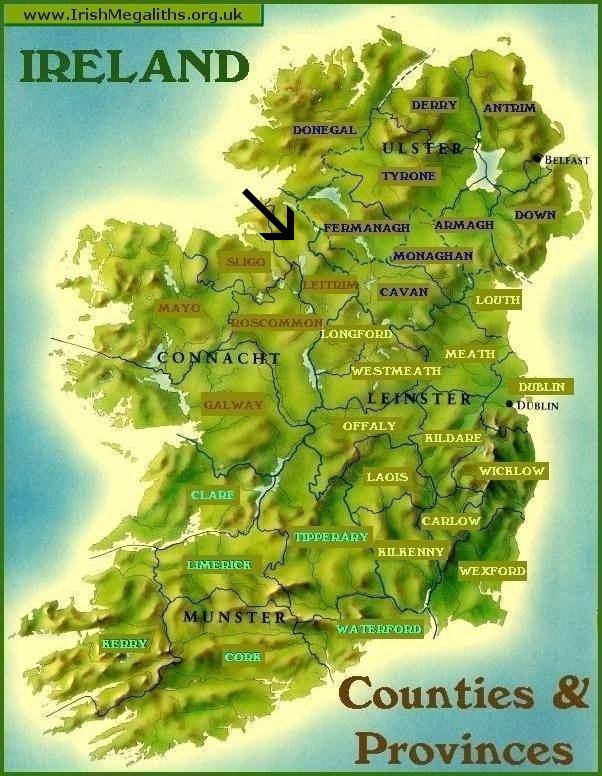
APPENDIX I
In a
quasi-erudite essay on 'Irish
Soma', Peter Lamborn Wilson (aka Hakim
Bey) asked if Psilocybe and Fly Agaric (Amanita muscaria)
grew in Ireland in ancient times. Of course they did -
in huge numbers.
I am interested in this
question because I take microdoses (1 gram) of Psilocybe
twice a week to alleviate mild bipolarity, and they work
marvellously well. Can Psilocybe semilanceata have
escaped the attention of people in Europe (and on the
Mainland to this day) who could distinguish between wholesome,
tasty mushrooms such as the once-ubiquitous Agaricus
campestris and similar-looking poisonous ones)
and who knew very well the effects (both salutary and
dangerous) of Fly Agaric ?
Sweathouses were apparently
used mainly in autumn, when Psilocybe semilanceata
was plentiful. Could it have been a secret part of the
treatment – for example, the 'herbs' administered
by the Old Woman mentioned above ?
For a couple of years I
took microdoses of Psilocybe 'truffles' to alleviate depression,
and they worked well - until they didn't.
The sameness of reports
on sweathouses is suspiciously similar to the uniformity
of other rural pseudo-myths, such as dock-leaves relieving
nettle-stings, bats nesting in hair, or the definition
of prehistoric tombs as Giant's Graves.
APPENDIX
II
from
the Birmingham (Warwickshire) City Council's website:
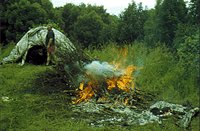
Reconstruction |
Over 30 "burnt mounds" have
been found in Birmingham. These are low mounds,
usually 10 to 15m across, composed of heat-shattered
stone, charcoal and ash. Some of Birmingham's
burnt mounds have been dated to between 1500 and
1000 BC by radiocarbon dating of the charcoal.
Excavation of a burnt mound visible as a layer of
burnt stones in a stream bank at Cob Lane in Bournville
in 1980 and 1981 showed that it originally lay in
a stream meander. Under the burnt mound, there were
a burnt hollow, a timber and clay-lined pit next
to the former stream bank, and many holes resulting
from pointed branches being pressed into the ground.
The former stream bed contained remains of beetles.
The different beetle species indicate what the environment
was like 3000 years ago, and included species usually
found where animals are grazing. The silty clay
on which the mound had accumulated is likely to
be soil which had been loosened by ploughing on
the slopes above the site, providing further evidence
for prehistoric farming.
Burnt mounds are usually interpreted
as the débris from when ancient people made
water boil to cook food by dropping heated stones
into it. Although experiments have shown that this
could have been the case, we would expect to find
animal bones and other débris from food preparation
and cooking.
Another interpretation is that they are the debris
from steam or sauna-type bathing. In North American
Indian Sweat Lodges, steam is produced for
bathing by pouring water over heated stones inside
a tent or hut. Reconstructions based on the excavated
evidence from the Cob Lane site and the structures
used by North American Indians have shown that burnt
mounds could well have been saunas. The reconstruction
consists of a hearth on which the stones are heated
and a tent on a framework of bent-over branches.
The heated stones are placed in a hollow inside
the tent and water ladled onto them from a clay-lined
pit, to produce steam. This reconstruction replicates
all the features found in the Cob Lane excavation:
the shattered stones and charcoal which is the débris
from the hearth, the holes resulting from the pointed
branches used to make the tent, the burnt hollow
which is where the hot stones are placed, and the
clay-lined pit next to the former stream line.
(copied July 2002)
Note that 'Burnt Mounds'
in Ireland are known as Fulachta Fía[dh]
- and that in the above there is no reference to
Irish Sweathouses.
|
ANCIENT
IRISH BREWERIES ?
from The Irish Examiner
11th August 2007
by Sarah Stack
«
Bronze age Irish men were as fond of their beer
as their 21st century counterparts, it was claimed
yesterday.
Two Galway archaeologists have put forward
a theory that one of the most common ancient monuments
around Ireland may have been used for brewing
ale.
They
believe that fulachta fiadh - horseshoe
shaped, grass-covered mounds which were conventionally
thought of as ancient cooking spots - could have
been the country's earliest breweries.
To
prove their belief that an extensive brewing tradition
existed in Ireland as far back as 2500 BC, Billy
Quinn and Declan Moore recreated the process.
After just three hours of hard work, and three
days of waiting for their brew to ferment, the
men enjoyed a pint of the fruits of their labour.
Three hundred litres of water was transformed
into a "very palatable" 110 litres of
frothy ale.
"It
tasted really good," said Mr Quinn.
"We were very surprised. Even a professional
brewer we had working with us compared it favourably
to his own. It tasted like a traditional ale,
but was sweeter because there were no hops in
it."
Mr
Quinn said it was while nursing a hangover one
morning, and discussing the natural predisposition
of men to seek means to alter their minds, that
he came to the startling conclusion that fulachta
fiadha could have been the country's earliest
breweries.
The
two set out to investigate their theory in a journey
which took them across Europe in search of further
evidence.
On their return they used an old wooden trough
filled with water and added heated stones. After
achieving an optimum temperature of 60°C to
70°C they began to add milled barley, and
about 45 minutes later simply bailed the final
product into fermentation vessels. They added
natural wild flavourings and yeast after cooling
the vessels in a bath of cold water for several
hours.
Tomorrow
they plan to start work on a fourth batch they
hope will taste as good as their first.
The archaeologists, who reveal their experiment
in full in next month's Archaeology Ireland,
point out that while their theory is based on
circumstantial and experimental evidence, they
believe that, although fulachta fiadh were
probably multifunctional, a primary use was for
brewing beer. »
|

|

DOWNLOAD
THESE TWO PAGES AS A PDF FILE
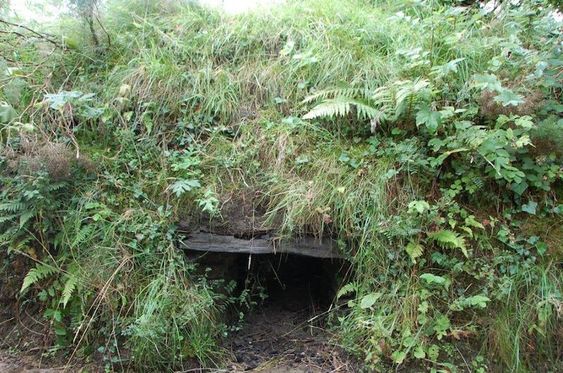
Sweathouse near Keadue, county Roscommon.
|
SELECT
BIBLIOGRAPHY
Bolton, Jason 2005. The sweat houses of Leitrim.
https://jasonbolton.
wordpress.com/2014/12/21/the-sweat-housesof-leitrim/.
Cagney,
Lydia 2003. Report on the archaeological excavation
of Fulacht Fiadh at Ballinaspig More 6, Ballincollig,
Co Cork. Archaeological Consultancy Services Ltd.
Danaher,
Kevin, Lucas, A.T. 1952. Sweathouse, Co. Tyrone. Journal
of the Royal Society of Antiquaries of Ireland 82 (2), 179–180.
Dowd, Marion
2018. Bewitched by an Elf Dart: Fairy Archaeology, Folk
Magic and Traditional Medicine in Ireland. Cambridge
Archaeological Journal 28 (3), 451–473 https://www.cambridge.org/core/journals/cambridge-archaeological-journal/article/bewitched-by-an-elf-dart-fairy-archaeology-folk-magic-and-traditional-medicine-in-ireland/7EF2D9BD63A34CAA405A42E120C4D421
Edelsward,
Lisa-Marlene 1991. Sauna as Symbol: Society and Culture
in Finland. American University Studies, Series XI: Anthropology
and Sociology vol. 53. Peter Lang, New York.
Fairbrother,
Andrew 2019. Irish Sweat-Houses: An Experimental Archaeological
Investigation and Study. School of Archaeology. University
College Dublin. (Unpublished Masters dissertation.)
García-Quintela,
Marco V., Santos Estévez, Manuel 2015. Iron Age
Saunas of Northern Portugal: State of the Art and Research
Perspectives. Oxford Journal of Archaeology 34 (1), 67–95.
Harte,
Aidan 2010. The Munster Sweathouses Project. North
Munster Antiquarian Journal 50: 77–88.
Harte,
Aidan 2012. An Teach Allais – an archaeological
examination of the Irish Sweathouses of Munster, South Leinster
and West Connaught. Munster Archaeology 5.
Harte,
Aidan 2021.
Leitrim
Sweathouse Project Report 2021
Hernández-Ávila,
Inés 1996. Mediations of the Spirit: Native American
Religious Traditions and the Ethics of Representation. American
Indian Quarterly 20 (3/4), 329–352.
Inchon,
Alain 1977. A Late Postclassic Sweathouse in the Highlands
of Guatemala. American Antiquity. 42 (2), 203–209.
Keaney,
Harry 2010. Vikings had a much bigger presence in Sligo
than had been first thought. The Irish Independent. https://www.independent.ie/regionals/sligochampion/lifestyle/vikings-had-a-much-bigger-presence-in-sligo-than-had-been-firstthought-27568729.html.
Kearns,
Katie 2016. Understanding sweathouses in Ireland with
special reference to County Leitrim. University College
Dublin. (Unpublished Masters dissertation.)
Kearns,
Katie 2021. The
Sweathouses of Ireland : The
disappeared folk-tradition of sweat bathing.
Latimer,
W.T. 1894. Sweat-House, near Eglish, County Tyrone.
Journal of the Royal Society of Antiquaries of Ireland
4 (2), 180.
Lockwood,
F.W. 1901. Some Notes on the Old Irish “Sweat-Houses”
at Assaroe, Ballyshannon; And Kinlough, Co. Leitrim, and
on Several Rude Stone Monuments near Bundoran and Ballyshannon.
Ulster Journal of Archaeology 7 (2), 82–84.
Logan,
Patrick 1972. Making the cure: a look at Irish folk
medicine. Talbot press, Dublin.
May, A.
McL 1938. Sweat Houses (Toigthe Alluis) of County Londonderry.
Ulster Journal of Archaeology 1938 (1), 44–45.
McCormick,
Finbar 2017. Struell: bathing at midsummer and the origins
of holy wells. BisWorch C. – Theune C. (eds.) Religion,
Cults & Rituals in the Medieval Rural Environment.
Ruralia XI. Sidestone Press, Leiden, 69–77.
Mc Hugh,
B. 2002. Sweathouses – The Irish Sauna. Killavoggy.
Leitrim: Carrick Print, 21.
Miller,
Catherine. A. 2013. Earth. Water. Sky – The Liminal
Landscape of the Maya Sweatbath. Doctoral dissertation.
Virginia Polytechnic Institute and State University.
Milligan,
Seaton. F. 1889. The Ancient Irish Hot Air Bath. Journal
of the Royal Historical and Archaeological Association of
Ireland 9 (81), 268– 270.
Moriarty,
Colm 2012. The enigmatic fulacht fiadh or burnt
mound. Irish Archaeology.
http://irisharchaeology.ie/2012/07/the-enigmatic-fulacht-fiadhburnt-mound/.
Mulcahy,
D.B. 1891. An Ancient Irish Hot-Air Bath, or Sweat-House,
on the Island of Rathlin. Journal of the Royal Society
of Antiquaries of Ireland 1 (7), 589–590.
National
Monuments Service (NMS). Sites and Monuments
Record (SMR). 2011. Anaverna, Co. Louth. SMR no.: LH004-123---.
Compiled by: Claire Breen. NMS. SMR. 2009. Ballyourane,
Co. Cork. SMR no.: CO132-009002-. NMS. SMR. Carrowmaloughlin,
Co. Mayo. SMR no.: MA087-064----. NMS. SMR. 2010. Crosshill,
Co. Roscommon. SMR no.: RO002-024----. Compiled by: Michael
Moore.
O’Donovan,
Patrick F. 1995. Archaeological Inventory of County
Cavan. Stationery Office, Dublin, 239–243.
Ó
Giolláin, Diarmuid 2000. Locating Irish Folklore:
Tradition, Modernity, Identity. Cork University Press,
Cork.
Richardson,
P. 1939. Sweathouses between Blacklion and Dowra, County
Cavan. Ulster Journal of Archaeology 1939 (2), 32–35.
Sando,
Linnea C. 2014. The Enduring Finnish Sauna in Hamlin
County, South Dakota. Material Culture, 46 (2), 1–20.
Singh,
Manvir 2025. Shamanism: The Timeless Religion,
Allen Lane, London.
Wakeman,
W.F. 1890. The Hot-air Bath. The Proceedings and
Papers of the Royal Society of Antiquaries of Ireland. Fifth
series. 2 (1), 165.
Weir, Anthony
1979. Sweathouses and simple stone structures in County
Louth and elsewhere in Ireland. County Louth Archaeological
and Historical Journal. 19 (3), 185–196.
Weir, Anthony
1989. Sweathouses: puzzling and disappearing. Archaeology
Ireland, 3 (1), 11–13.
(It was this article, Aidan Harte told
me by e-mail, which inspired him to study sweathouses, and
which, in turn, led to the Leitrim Sweathouse Project -
see above.]
Williams,
Brian 2014. Cornacully, Fermanagh. http://www.excavations.ie/report/1988/Fermanagh/0000791/.
Some
Online Archive Sources
Aghameen, Co. Louth. https://www.duchas.ie/en/cbes/5008815/4958559.
Ballymahon.
Co. Longford. https://www.duchas.ie/en/cbes/5009142/4990873.
Brideswell,
Co. Roscommon. https://www.duchas.ie/en/cbes/4811596/4800327.
Buckode,
Co. Leitrim. https://www.duchas.ie/en/cbes/4602728/4599005.
Carrickmore,
Co. Armagh. https://www.jstor.org/stable/48568195
Carrowmenagh,
Co. Donegal. https://www.duchas.ie/en/cbes/4493786/4420259.
Cartronavally,
Co. Roscommon. https://
www.duchas.ie/en/cbes/4758451/4745077.
Clones,
Co. Monaghan. https://www.duchas.ie/en/cbes/4723856/4719443.
Cloontamore,
Co. Longford.
https://www.duchas.ie/en/cbes/5009152/4992177.
Cloonty,
Co. Leitrim. https://www.duchas.
ie/en/cbes/4602726/4598692.
Corellstown,
Co. Westmeath. https://www.duchas.ie/en/cbes/5009057/4981914.
Cornageeha,
Co. Leitrim. https://www.duchas.ie/en/cbes/4605944/4604551.
Cornamucklagh
North, Co. Leitrim. https://www.duchas.
ie/en/cbes/4605945/4604677.
Corratawy,
Co. Cavan. . https://www.duchas.ie/en/cbes/5044788
/5038152/5081569.
Doon. Co.
Limerick. https://www.
duchas.ie/en/cbes/4922081/4850597.
Drumkeeran,
Co. Leitrim. https://www.duchas.ie/en/cbes/4605932/4603675.
Drumshanbo,
Co. Leitrim. https://www.duchas.ie/en/cbes/4605949/4605190.
Drumaweir,
Co. Donegal. https://www.duchas.ie/en/cbes/4758450/4745008.
Greaghnafarna,
Co. Roscommon. https://www.duchas.ie/en/cbes/4758450/4745008.
Killoscully,
Co. Tipperary. https://www.duchas.ie/en/cbes/4922154/4856704/5012408.
Manorhamilton,
Co. Leitrim. . https://www.duchas.ie/en/cbes/4602749/4600924.
Mullaun,
Co. Leitrim. https://www.duchas.ie/en/cbes/4602754/4601327.
Shancurry,
Co. Leitrim. https://www.duchas.ie/en/cbes/4605955/4605654.
Toor, Co.
Tipperary. https://www.
duchas.ie/en/cbes/4922161/4857271.
Urball,
Co. Leitrim. https://www.duchas.ie/en/cbes/4605947/4604866/4652069.
Valleymount,
Co. Wicklow.https://www.duchas.ie/en/cbes/5044723/5034522.
plus
:
https://www.indiancountryextension.org/the-navajo-sweat-house-a-ceremonial-purification-ritual
https://www.jstor.org/stable/27729480
(My original article from 1979 on co. Louth sweathouses.)
THE_SWEATHOUSES_OF_IRELAND_THE_DISAPPEARED_FOLK_TRADITION_OF_SWEAT_BATHING
in which I am placed in 'the early twentieth
century'!
More
accounts >

see
also the
Leitrim
Sweathouse Project Report 2021
which
contains photos and a full discussion.
|
Recently I found this picture of a sweathouse in county Leitrim
in an article in Malayalam
on a Kerala (South India) newspaper website.
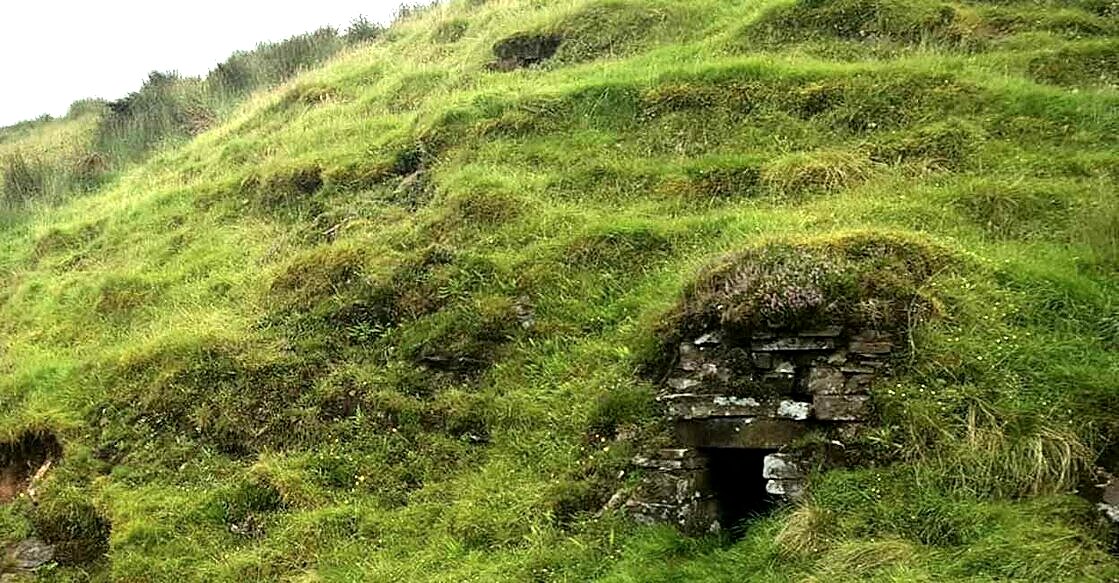
|
|
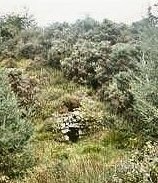






























 larger photo
larger photo






